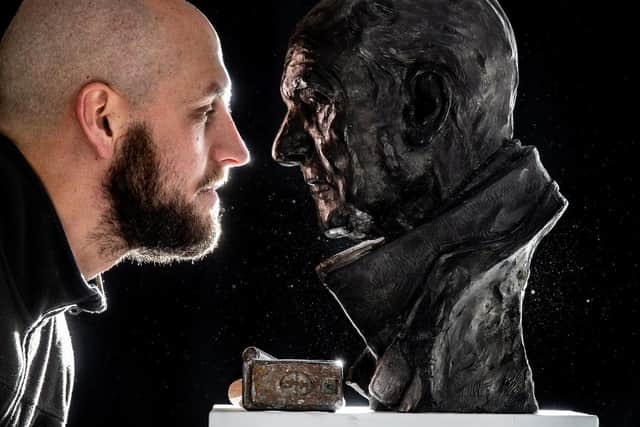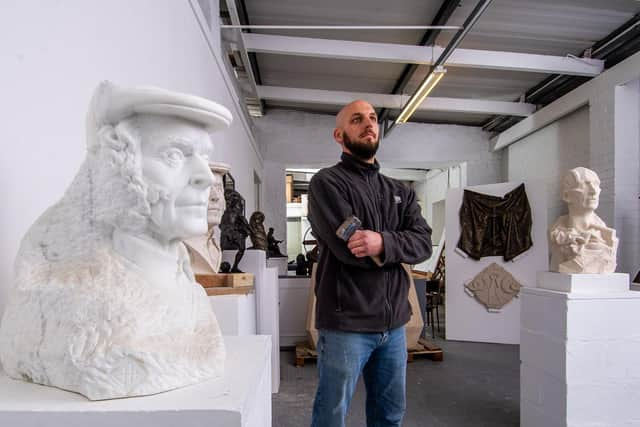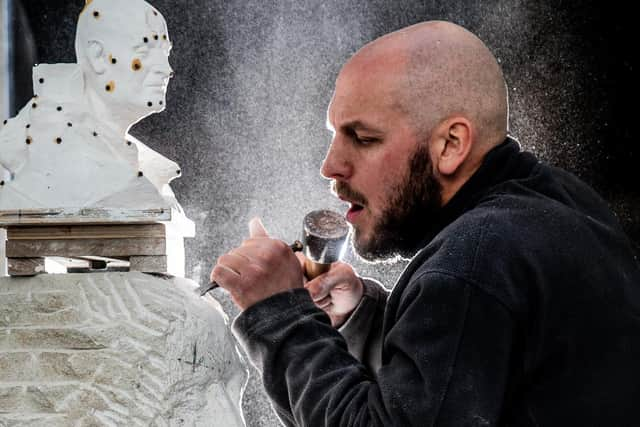Meet the former stonemason carving out an impressive reputation as a sculptor from a studio in Pateley Bridge
“Yes, that can happen,” he says, before explaining why it never does. “You rarely buy a naturally rough block where you might see a shape in there. You buy what you call formed six-sided blocks. It literally comes as a cube or an oblong.”
All the better for being cut and processed. A rough block might wait to reveal its faults until it has made heavy progress to the studio. Sawn stone rarely presents such problems.
Advertisement
Hide AdAdvertisement
Hide AdJoseph gives the question another prod. “I dare say if I did get a stone in rough form I would see forms… but it doesn’t work like that.”


Handily, it does work as an image for a writer seeing the shape of a story in a pile of notes.
Hayton is speaking on the phone from his gallery and studio at the King Street Workshops, in Pateley Bridge, and I am asking questions from my study in York. Better to have been there for the dust and chisel, but that’s not so easy these days.
Hayton, who is 33, has been in the workshops for nine years. He recalls visiting them as a toddler with his father to see a glass-blower at work.
Advertisement
Hide AdAdvertisement
Hide AdAlthough he does an array of work, he sees himself as a figurative sculptor. “My main area of interest is portraiture and the human figure,” he says.


He’s just moved into a new unit with a large workshop and display area. A practical man bent to a practical art, he’s been busy sorting it out. “There’s a lot to do. You don’t know how much you’ve got until you move,” he says.
Growing up, Hayton liked art and design technology, making things in other words. He drew from a young age. “The earliest artistic memory I have is drawing a jar of daffodils in pastel,” he says. “I remember getting so much praise. I thought I must be good at this – I was four or five.”
He studied art and sculpture in the sixth form at South Craven School, where an art teacher gave him pieces of soapstone, white like marble but softer. “It’s a lovely stone to carve, he says.


Advertisement
Hide AdAdvertisement
Hide Ad“The art room had one gouge chisel which is like a curved chisel for carving stone, and I got a carpenter’s hammer, and somehow I knew it needed to be a softened blow, so I wrapped the end in hessian. I carved the palm of a hand and it was pretty good, I was about 17.”
Hayton then studied stonemasonry at York College on an apprenticeship scheme with Yorkshire Stone Craft, in Halifax. “When I was training as a mason it was a good time,” he says. “But after five or six years I got the itch for doing more elaborate work. I wanted to get back to doing more artistic things than I was allowed to do.”
His job had become just that, a job. So he moved into King Street, where the units showcase jewellery, millinery and textile making, and where there is still a glass-blower.
The public can watch the artists at work and ask questions. “Usually with sculpture and painting, people see it in a gallery setting and you very rarely see the workings – how the sausage is made,” he says. “I can discuss the working process and the tools and people find it interesting.”
Advertisement
Hide AdAdvertisement
Hide AdHe is inspired by the human form, particularly the head, and creates one-off figurative pieces and portrait sculptures in stone and bronze. He will also make bespoke stone fireplaces and one-off garden ornaments.
His latest project, a statue for a city centre in the UK, has to remain secret for now. “That’s as much as I can tell you. I’m involved in about three projects that are the same.”
When a town wants to erect a statue he discusses it with committees and steering groups, then makes the maquette – a model of the statue – to be used in fundraising.
“One I can tell you about is that I got involved in a supporters’ group from Burnley Football Club. There are plans for a nine-foot bronze statue of Jimmy McIlroy at Turf Moor. That’s one I’ve been involved in for a couple of years and have the maquette in the studio here. One day hopefully they’ll get the money together.”
Advertisement
Hide AdAdvertisement
Hide AdHayton’s work revolves around stone. “When you’re self-employed there’s good times and there’s bad times, and it is a bit hand to mouth sometimes, but it’s not a bad living. I can turn my hand to stone sculpture which is quite rare these days as a lot of sculptors work in bronze. I do work in bronze as well, so I can supply anything from wildlife bronzes and figurative pieces to stone sculpture to unusual pieces for people’s gardens and garden sculptures.”
Sculpture is a slow trade. Stone carving is slow and difficult, and it’s a physical ordeal just to move the stone. “When you get down to the detail, it takes a long time to get the stone to do what you want it to do,” he says.
“The bronze side of things is slow too, and that’s a whole different process. I make a clay master and then make moulds from that clay piece using silicone rubber and fibreglass. Those moulds are then sent off to a foundry and the foundry gets wax out of those moulds, which then I have to go and check. And then that wax is used in casting, which is also a long process.”
If you order a bronze sculpture, don’t expect to see it in a hurry. They can take months. Hayton sends his bronze work to Aron McCartney’s foundry in Barnard Castle.
Advertisement
Hide AdAdvertisement
Hide AdFor all his skill he readily admits he’s still learning the craft. “I’m getting better all the time. I look at some of my older work and cringe a bit,” he says.
He has a mentor in the sculptor James Butler. “I idolise him in a way. He’s in his 90s and he’s someone I really look up to.” He’s visited his studio in Warwick many times. “He is a monumental sculptor who does a lot of war memorials and statues of historical people. I’ve learnt a lot. He’s invited me to take maquettes down to the studio for him to critique, which I’ve done with my latest one, but over email this time because of the virus.”
On one of his earliest visits, Hayton asked if he could do a portrait of Butler. The bronze portrait later won the Society of Portrait Sculptors Tiranti Prize for the best work by a sculptor aged 30 and under. “He’s a great guy, great to have in my life,” adds Hayton.
Two years ago, he staged an exhibition at Fountains Abbey based on the habits worn by monks. “I’m still working on that side of things but it’s evolved. The work has developed, it’s become more stylised.”
Advertisement
Hide AdAdvertisement
Hide AdHe describes the piece as an over life-sized head containing hints of architecture. “My work is moving away from this literal work, it’s becoming more abstract.”
When he’s not hard at work in his studio, he’s at home in Silsden with his wife Kimberley and their baby daughter. “She keeps us busy,” he says. “I don’t have many hobbies. My main hobby is what I do... sculpture.”
www.josephhayton.co.uk
Support The Yorkshire Post and become a subscriber today. Your subscription will help us to continue to bring quality news to the people of Yorkshire. In return, you'll see fewer ads on site, get free access to our app and receive exclusive members-only offers. Click here to subscribe.